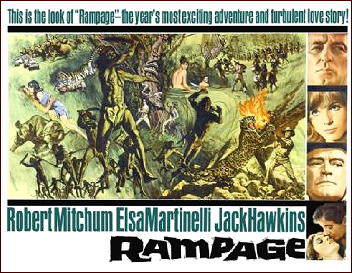September 2010
Monthly Archive
Fri 17 Sep 2010
Reviewed by DAVID L. VINEYARD:
RAMPAGE. Seven Arts/Warner Brothers, 1963. Robert Mitchum, Elsa Martinelli, Jack Hawkins, Sabu. Screenplay: Robert Holt & Marguerite Roberts, based on the novel by Alan Caillou. Director: Phil Karlson.
Anna (Elsa Martinelli) mistress of hunter Otto Abbott (Jack Hawkins) : What of the hunter, Otto? Is the hunter only satisfied when he makes of his prey a trophy, a thing to possess?
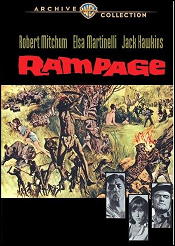
Harry Stanton (Robert Mitchum) is the world’s greatest animal trapper. Otto Abbott is the world’s greatest hunter. The Munich Zoo has hired the two of them to go on Shikar (safari) in Malaya to bring back two tigers, and the prize of the expedition … the Enchantress, a legendary leopard with many kills to her name. [NOTE: See Comment #1.]
Harry: Anything can happen on Shikar. Some things you plan, some things you don’t.
From the first, the laid back Harry is intrigued and repulsed by Otto Abbott. The charming German lives for the kill and for acquisition of trophies — including his beautiful young mistress Anna (Elsa Martinelli), who he displays her as another of his trophies.
Anna is much younger than Otto. He took her out of an orphanage when she was only fourteen, and he takes some pride in her lovers, her faceless lovers, but Harry is something different — Harry promises to have a face.
Once in Malaya Otto finds himself playing second fiddle to Harry and he doesn’t like it. The local chief doesn’t like his arrogant ways, and Anna begins to see Harry more and more as a man with a face.
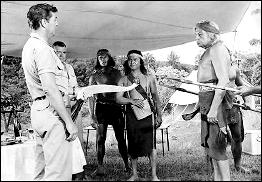
They capture the first two tigers easily, but Otto alienates the chief and they lose the help of the locals so Harry has to trap the Enchantress with only the help of his trackers led by Sabu (in his next to last film).
By the time Harry traps the Enchantress in a native temple Anna is in love with him and Otto has faced both his mortality and his courage — broken without a gun to back it up. Otto’s world has been turned upside down and Anna is planning to leave him. Worst of all is Anna’s pity.
Otto: I had a talent for killing. Now it’s gone. Abbott the hunter is finished. What of Abbott the man?
The train reaches Munich and the Enchantress escapes:
Otto: What was it you said about the law in the jungle? Survival wasn’t it? Well, let’s see you survive.
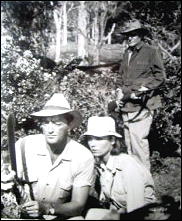
Now Harry and Anna with the Munich police as beaters must stalk the rooftops of the city for the killer cat while Otto hunts them.
Rampage is a fine old fashioned adventure film based on a novel by adventure writer Alan Caillou. Caillou, in addition to writing such books as Journey to Orassia, Assault on Agathon, and the “Cabot Cain” and “Col. Tobin” series, was a busy character actor whose extensive career included roles in too many television series to count and playing Inspector Lestrade in the 1972 made-for-television The Hound of the Baskervilles and uncredited in The List of Adrian Messenger (Inspector Seymour) and Journey to the Center of the Earth (the Rector). He was a regular on the science fiction comedy series Quark as “the Head” and appeared in the mini series Centennial, and as Fergus in four episodes of My Three Sons.
Phil Karlson had a long and varied career, directing everything from Kane Richmond as The Shadow to Dean Martin as Matt Helm, but he also helmed fine adventure films like Rampage and the classic film noir Kansas City Confidential.
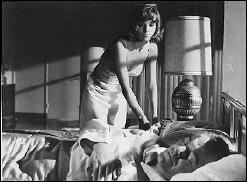
Rampage also benefits from a terrific film score by Elmer Bernstein that ably enhances the action and mood and a great song written with Mack David. That and Karlson’s direction, a first rate cast, and literate script raise it far above the simple adventure film it actually is.
The film ends memorably on an apartment rooftop with Harry trapped between the maddened Enchantress and murderous Otto with a gun.
Otto: I should have killed you when I had the chance.
This kind of film may seem old hat compared to today’s kinetic CGI ridden action films, but it is nice to watch it and notice the care taken to develop character and relationships.
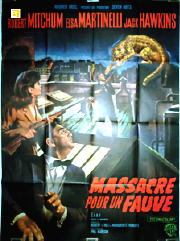
The three leads, and even Sabu and his wife and the old chief are deeper and more rounded than many of their contemporaries today in a similar type of film. It’s that level of writing and direction that give this film a little something missing in many modern films.
The more leisurely style allows the actors room to show a little depth and dimensionality and adds to the tension so when the action does occur it is explosive.
In short, it’s a movie and not a live action cartoon. Nothing wrong with live action cartoons, but films like Dark Knight, Inception, the Bourne films, and the Daniel Craig Bond’s show that modern audiences can appreciate the deeper characterization and more rounded characters.
Rampage is a slick smart adventure film that will leave you well satisfied, and what more can you want from an adventure movie? It’s an old fashioned popcorn movie. Get the microwave ready, heat up the butter, and stock up on Junior Mints, this is old time movie making the way it used to be done with style and genuine storytelling skill.
At the time it was just another good film, but now it is a reminder of the skills once common in movie making.
Fri 17 Sep 2010
A 1001 MIDNIGHTS Review
by Bill Pronzini:
LEO BRUCE – Case for Three Detectives. Stokes, US, hardcover, 1937. Hardcover reprint: Academy Chicago, October 1980; trade paperback, 1985. British edition: Geoffrey Bles, hardcover, 1936.
Case for Three Detectives is at once a locked room mystery worthy of John Dickson Carr and an affectionate spoof of the Golden Age detectives created by Sayers, Christie, and Chesterton.

When Mary Thurston is found in her bedroom, dead of a slashed throat, during a weekend party at her Sussex country house, it seems to all concerned an impossible, almost supernatural crime:
The bedroom door was double-bolted from the inside; there are no secret passages or other such claptrap; the only windows provide no means of entrance or exit; and the knife that did the job is found outside the house.
The following morning, three of “those indefatigably brilliant private investigators who seem to be always handy when a murder has been committed” begin to arrive. The first is Lord Simon Plimsoll (Lord Peter Wimsey): “… the length of his chin, like most other things about him, was excessive,” the narrator, Townsend, observes.
The second is the Frenchman Amer Picon (Hercule Poirot): “His physique was frail, and topped by a large egg-shaped head, a head so much and so often egg-shaped that I was surprised to find a nose and mouth in it at all, but half-expected its white surface to break and release a chick.”
And the third is Monsignor Smith (Father Brown), “a small human pudding.” The three famous sleuths sniff around, unearth various clues, and arrive at separate (and elaborate) conclusions, each accusing a different member of the house party as Mary Thurston’s slayer.
But of course none of them is right. The real solution is provided by Sergeant Beef of the local constabulary, “a big red-faced man of forty-eight or fifty, with a straggling ginger moustache, and a look of rather beery benevolence.”
Along the way there is a good deal of gentle humor and some sharp observations on the methods of Wimsey, Poirot, and Father Brown. The prose is consistently above average, and the solution to the locked room murder is both simple and satisfying.
Sergeant Beef is featured in seven other novels by Leo Bruce (a pseudonym of novelist, playwright, poet, and scholar Rupert Croft-Cooke), most of which have been reissued here by Academy Chicago in trade paperback. Among them are Case Without a Corpse (1937), Case with Four Clowns (1939), and Case with Ropes and Rings (1940). Each is likewise ingeniously plotted and diverting.
———
Reprinted with permission from 1001 Midnights, edited by Bill Pronzini & Marcia Muller and published by The Battered Silicon Dispatch Box, 2007. Copyright © 1986, 2007 by the Pronzini-Muller Family Trust.
Thu 16 Sep 2010
Posted by Steve under
Reviews[2] Comments
COLIN D. PEEL – Snowtrap. Doubleday Crime Club, US, hardcover, 1985. Hardcover reprint: Detective Book Club, 3-in-1 edition, no date. No paperback edition. First published in the UK: Robert Hale, hardcover, 1981.
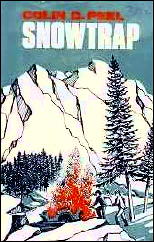
A New Zealander by choice and an Englishman by birth, Colin Peel has written at least 15 spy/adventure thrillers since 1973. Of these, this is the only one I’ve read. And if it weren’t the third in this particular volume of a Detective Book Club three-in-one, it might have been a while before the opportunity arose again — of Peel’s sizable output, only two of his novels have been published in the US in paperback (neither one this one).
I say this even though I once upon a time took it upon myself to collect all of the hardcover Doubleday Crime Club mysteries. That was a long time ago, and I probably had a copy at one time, but if I still do, I am embarrassed to say that I could not locate it if I had to.
And as long as I am digressing, let me recommend the DBC editions as a source of (usually) inexpensive detective stories, mysteries and spy adventures like this one, books that never came out in paperback, like this one, and which almost always provide solid and non-negotiable amounts of entertainment, like this one.
And sometimes even more, as the Mignon Warner book (Speak No Evil) reviewed here not so long ago proves, and the one by H. Paul Jeffers (Murder on Mike) as well. That this one’s the lesser of the three does not mean it’s not worth reading. Far from it!
But as far as spy thrillers go, it’s short — only about 190 pages of medium to large-sized print — and even though former military flyer John Vega might have been a character worthy of further (um) characterization, the book’s simply too short to be more than event-oriented.
Vega and Lynne Morrow, the girl (of course) who gets him involved with activities well over his head, are the only people in the story who are more than shadows, and if they were to step sideways, you probably wouldn’t see either one of them either.
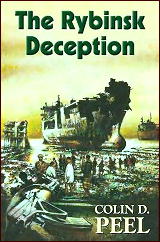
It starts with Vega hijacking a Mirage jet at an Australian airport, bombing a nearby uranium mine, and blasting two freighters out of the open sea. It’s one heck of an opening act, that’s for sure, and the twist that quickly snaps back at him is a doozie as well.
What the story needs, and doesn’t quite get, is a finale that’s worthy of these spectacular attention-grabbing devices. Restricted, I’m sure, by the limitations in wordage, set by the markets he was writing for, Peel does his best, but even in 1981 the ending’s one that had been done before, and with the characters so indifferently involved up to then, he simply comes up short, gasping and (figuratively) out of breath.
When you’re competing in Ian Fleming territory, in other words, as an author, you can’t just let it slip away at the end.
[UPDATE] 09-16-10. A better count of Colin Peel’s novels appears to be in the two dozen or so range, including two written under two different pen names. I have not yet determined if all are criminous, a category that includes spy and espionage fiction, but the good news is that as of last year, the author was still writing: The Rybinsk Deception (as seen above) came out in 2009.
Thu 16 Sep 2010
Posted by Steve under
Reviews[5] Comments
REVIEWED BY BARRY GARDNER:
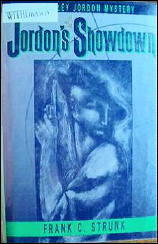
FRANK C. STRUNK – Jordan’s Showdown. Berkley Jordan #2; Walker, hardcover, 1993.
This is the second in a series set in Kentucky coal-mining country in the Depression era. I missed the first, Jordan’s Wager (Walker, 1991).
Berkley Jordan is about 50, and after being defeated in a bid for the Sheriff’s office is working for a lady who runs a poolroom and gambling house. He broke up with his true love after events in the first book, and is feeling a bit down about it.
The book opens with a hired assassin shooting a miner on his front porch. We don’t know who, or why. The stage is quickly set as we learn that the union is coming to the mining town where Jordan lives, or at least the miners hope it is.
Jordan is determined to stay neutral, but it’s proving hard. Not only are the miners pressuring him, but the owner of the mining town calls him in and asks him to help in avoiding a possible bloodbath. Jordan remains stubborn, but then the assassin kills again. This time the victim is close to Jordan, and he can remain aloof no longer.
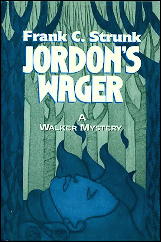
This is both a regional and historical crime novel (not really a mystery) and Strunk handles both aspects well, evoking the atmosphere of both time and place. He switches viewpoints among Jordan, the killer, and the mine owners, and moves the story along effectively. Union boss John L. Lewis and Kentucky Lieutenant Governor “Happy” Chandler (baseball fans will remember him) make appearances toward the end.
As I said, it really isn’t a mystery; we know who and why long before the end. It is, however, a well done story with believable characters and an appealing lead. I enjoyed it, and I’d like to read more of Strunk.
— Reprinted from Ah, Sweet Mysteries #10, November 1993.
Bibliographic Note: Unfortunately there were no further appearances of Berkley Jordan, only the two books and that was all. Frank C. Strunk did write another novel, though, one that appears in the Revised Crime Fiction IV, and that’s Throwback (Harper, 1996). It also takes place in rural Appalachia, but in the present day. An interview with the author can be found here.
Wed 15 Sep 2010
Posted by Steve under
Reviews[4] Comments
IT IS PURELY MY OPINION
Reviews by L. J. Roberts
DERYN LAKE – Death in the Valley of Shadows. Allison & Busby, UK, hardcover, November 2003; softcover: November 2004.
Genre: Historical mystery. Leading character: John Rawlings; 9th in series. Setting: England-Georgian period.
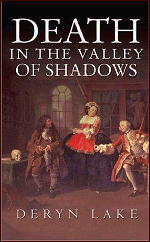
First Sentence: What a morning it had been.
Apothecary John Rawlings is surprised when a man, Aidan Fenchurch, runs into his shop asking to be hidden from his former mistress. Once the very unpleasant woman is gone, Fenchurch is pleased to hear John also assists Sir John Fielding, magistrate of Bow Street and asks that John keep a document accusing the woman should he suddenly die.
Fenchurch is murdered on his doorstep that night but his is only the first of many deaths with each new suspect dying before the killer can be identified by John and Bow Street.
Ms Lake has a clear and wonderful voice and writes with delightful humour. Her descriptions are so visual, you want to pack and go, yet so filled with background information, such as the scene with the salesman for sheaths and cundums, as to make you an informed traveler.
The details of social behavior and custom, as well as the syntax and cadence of dialogue define the story’s place and time. It is those extra details which enrich the story and add to the experience of reading it.
John is a character who has grown with the series. No longer a somewhat callow, but talented young man, he is now a mature and very responsible man who has a remarkably understanding wife. I particularly like his honesty to his wife and to himself, as to why he works with Bow Street.
Joe Jaco, first officer to Sir John Fielding (the Blind Beak), of Bow Street is an intriguing character, and one about whom we learn a bit more with each book. Although the author provides sufficient back story on the principal characters for readers new to the series, I recommend reading the series in order. There is an excellent balance to the story between John’s life with his family and friends, internal musings, medical knowledge and information, and the drama and suspense of the investigation.
The pacing and flow are very well done, fluctuating between highs and lows. The level of suspense increases to a very dramatic ending. Even the characters comment on the case having a Shakespearean feel in the number of bodies that accumulates. Only toward the end did I begin to suspect the killer.
I am an admitted fan of this series and this is another very good contribution to it. As I’m reading the series in order, it’s nice to know I’ve many more books ahead.
Rating: Very Good Plus.
Editorial Comment: Previously reviewed on this blog was The Mills of God, the first in author Deryn Lake’s contemporary Rev. Nicholas Lawrence/DI Dominic Tennant series.
There are now 13 adventures in her series of historical mysteries with 18th century apothecary John Rawlings as the leading character. He teams up with Sir John Fielding, London’s famous blind Bow Street magistrate, in most if not all of them. Covers for these can be seen on the Fantastic Fiction website.
Wed 15 Sep 2010
Posted by Steve under
Reviews[4] Comments
THE ARMCHAIR REVIEWER
Allen J. Hubin
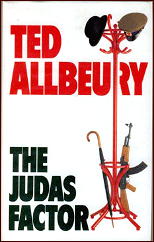
TED ALLBEURY – The Judas Factor. Mysterious Press, US, hardcover, 1987; reprint paperback, 1989. British edition: New English Library, hardcover, 1984.
Each time I sample Ted Allbeury I am rewarded. The Judas Factor is no exception. Allbeury’s bag is international intrigue, and his view is not all black and white but mostly gray, of men and women doing what they do for their own reasons, with their own ignorances and insights and rationalizations.
Tad Anders fell out of official favor with his masters in Britain’s S.LS., but they didn’t want to lose him altogether. So they set him up running a disreputable if successful London club, and ask him to take on the odd unofficial job.
Like extracting a Russian assassin from East Germany. The job is poorly planned and goes awry. In the end, one of the difficulties with unofficial spies is they’re a bit hard to control .
A solid, spare tale, and Tad and his women are particularly well met.
— From The MYSTERY FANcier, Vol. 11, No. 2, Spring 1989.
Previously reviewed on this blog:
Shadow of Shadows (by George Kelley)
The Reaper (by Steve Lewis)
Wed 15 Sep 2010
THE BACKWARD REVIEWER
William F. Deeck
XANTIPPE – Death Catches Up with Mr. Kluck. Doubleday Crime Club, hardcover, 1935. Film: Universal/Crime Club, 1938, as Danger on the Air (with Nan Grey as Christina “Steenie” MacCorkle & Donald Woods as Benjamin Franklin Butts).
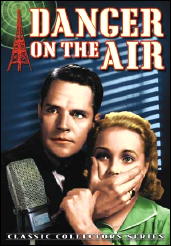
The Mr. Kluck, inventor, owner, and manager of Kluck’s Korjul — “Feeling depressed? Headache? Nervous? Drink Kluck’s Korjul. Lack pep, vitality? How about the sparkle in your eyes? Do you attract the opposite sex? For vim, vitality and vigor, drink Kluck’s Korjul, America’s fastest selling drink. . . ” — is at Radio Forum, Consolidated Broadcasting Company’s new studios, to watch one of his radio programs being produced. Unfortunately, he is a much unloved man, and no one mourns him when he dies in a sponsor’s room.
Kluck’s death is a complex one, first attributed to a heart attack, then to arsenic, and finally to carbon monoxide poisoning through the ventilating system. Doing the amateur investigating is Benjamin Franklin Butts, with the help of Finny McCorkle, of McCorkle, McCorkle, and Fish, radio productions. Butts has encyclopedic knowledge and Finny writes mystery scripts for radio.
Xantippe’s view of early radio, its alleged talent, and its programs is delightful and illustrates the saying that the more things change the more they stay the same. Even the footnotes are amusing, as well as being informative. The predictions for what radio might do for good and for harm are especially fascinating.
— From The MYSTERY FANcier, Vol. 11, No. 2, Spring 1989.
Editorial Comments: Bill Deeck did not know, or I assume that he would have mentioned it, but the exotically named Xantippe was the pseudonym of Edith Meiser, 1898-1993, herself the writer and producer of many radio programs, including the long-running Sherlock Holmes series, including the one that starred Basil Rathbone and Nigel Bruce for many years. One online source states that she wrote over 300 radio scripts for the series, far more stories than Sir Arthur did himself!
Xanthippe (meaning blonde horse in the Greek) was the wife of Socrates and the mother of their three sons. There may be some significance to this.
A complete listing of the Crime Club movies can be found in this preceding post from not too long ago. Danger on the Air itself has been released on DVD by oldies.com.
Tue 14 Sep 2010
BACKGROUND TO DANGER. Warner Brothers, 1943. George Raft, Brenda Marshall, Sydney Greenstreet, Peter Lorre, Osa Massen, Turhan Bey. Screenplay by W. R. Burnett, based on the novel by Eric Ambler (1937). Director: Raoul Walsh.
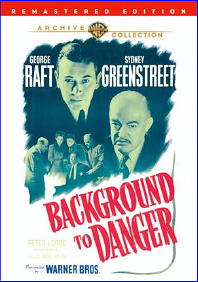
I think everyone who watches this movie today wonders who they might have cast in place of George Raft in the leading role. I also think that everyone who watches old movies like this one today wonders how it was that stony-faced George Raft was ever considered a movie star. He’s actually pretty good in this one, but it’s still a mediocre movie.
Would it still have been mediocre if Humphrey Bogart (say) had played Raft’s part? Maybe. That and a complete rewrite, that would have helped. As it is, I really think they missed the point of the book.
Raft plays a guy selling heavy machinery in the Middle East who meets a girl on a train who gives him an envelope filled with stock securities (she says) across the Syrian-Turkish border. Turns out that the contents are photos of maps indicating (falsely) Russia’s plan to invade Turkey.
Turns out that the Nazis are behind the scheme, and that Sidney Greenstreet is the man who thought it up as a way to drive Turkey away from Russia and into occupation by Germany. Turns out that Peter Lorre and Brenda Marshall are brother and sister (they say) and agents of Russia (again so they say), and it turns out that George Raft’s character is the guy right in the middle of everything.
Who is who and on which side they are is part of the mystery for a while, but this film is filled far more with talk than it is with action. Greenstreet has to explain his plan several times over, for example, just to make sure (one is allowed to assume) that the audience knows at least what his role is.
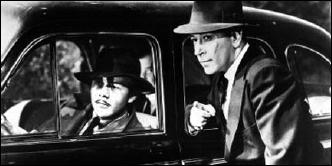
No film with both Greenstreet and Peter Lorre in it is completely bad. In fact, Peter Lorre is the one bright spot in the film, both broodingly mysterious and amusing, and sometimes in the very same scene. Usually the leading female is the bright light for me, but Brenda Marshall is not given very much to do. Too bad.
They also changed the story. I can’t say that I remember the details of the book, which I last read in the mid-50s, but of course the book was pre-war and the movie takes place while the was is going on. A small but significant change in perspective.
A bigger change, as I remember it, is that the hero in the book is an innocent who does his best, but when it comes to international politics, he’s in over his head. George Raft’s character – well I won’t tell you a whole lot more. He’s a tough guy who can take what’s dished out to him, but as I say, they really rewrote the part as far as he’s concerned.
And not for the better.
[UPDATE] 09-17-10. Mike Grost does an in depth critical analysis of this film on his website, in a page in which he discusses many of director Raoul Walsh’s films — an excellent piece of work!
Tue 14 Sep 2010
REVIEWED BY WALTER ALBERT:
THE BLACK DOLL. Universal Pictures/Crime Club Productions, Inc., 1938. Donald Woods, Nan Grey, Edgar Kennedy, C. Henry Gordon, Doris Lloyd, John Wray, Addison Richards, Holmes Herbert, William Lundigan, Fred Malatesta. Based on the novel by William Edward Hayes (1936). Director: Phil Karlson. Shown at Cinevent 42, Columbus OH, May 2010.
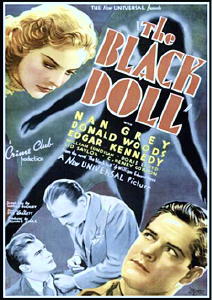
The usual excellent program notes failed to include the name of the author of the book, and it was incorrectly listed as by “William Edward Haynes” in the credits on IMDb. Ellen Nehr’s Doubleday Crime Club Compendium provided the correct attribution, as well as a thumbnail sketch of the plot that showed that the film made some attempt to follow the novel.
I say “some” because it was largely sabotaged by the performance by Edgar Kennedy as bumbling Sheriff Renick. And that’s a point I make with regret, since I’m a great fan of Kennedy, given the proper circumstance for his comedic gifts.
The film begins promisingly in the remote mansion of recluse Nelson Rood (C. Henry Gordon), who lives with his sister Laura Leland (Doris Lloyd) and her son Rex (William Lundigan). Rood’s relationships with his family are dysfunctional, as he rules his small kingdom with an iron and unforgiving fist.
The sudden appearance of a child’s toy, the titular black doll, arouses phantoms from his troubled past. When Rood is murdered that night, the police are summoned, with the arrival of Sherlff Renick and his antic crew dissipating the forbidding atmosphere that lent the film some tension and promise in the opening scenes.
Donald Woods plays the detective Nick Halstead (already on the scene as the boyfriend of Rood’s daughter Marian played by a distraught Nan Grey) with some grace and a dash of humor, as he negotiates the obstacles posed by the sheriff’s ineptitude and those members of the cast who are expected to take the proceedings seriously and form a veritable phalanx of red herrings.
As I recall, the other films in the Crime Club Series treated their material more seriously, if without enough distinction to make any of them figure in my pantheon of notable crime films.
Universal’s Crime Club series:
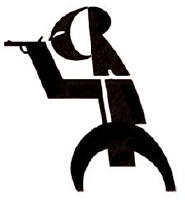
THE WESTLAND CASE (1937)
THE BLACK DOLL (1938)
THE LADY IN THE MORGUE (1938)
DANGER ON THE AIR (1938)
THE LAST EXPRESS (1938)
THE GAMBLING SHIP (1938)
THE LAST WARNING (1938)
THE MYSTERY OF THE WHITE ROOM (1939)
INSIDE INFORMATION (1939)
HOUSE OF FEAR (1939)
THE WITNESS VANISHES (1939)
[UPDATE] 09-15-10. For more information on the movies in this series, including the books and stories they were based on, see Comment #3. Not all of the films were based on Crime Club novels.
Tue 14 Sep 2010
REVIEWED BY DAN STUMPF:
COLLEGE SCANDAL. Paramount, 1935. Arline Judge, Kent Taylor, Wendy Barrie, William Frawley, Benny Baker, William “Billy” Benedict. Screenplay by Frank Partos, Charles Brackett & Marguerite Roberts, based on a story by Beulah Marie Dix & Bertram Millhauser. Director: Elliott Nugent.
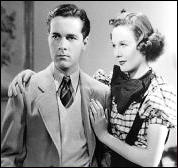
College Scandal sounds like a story ripped from today’s headlines or a typical 1930s musical with superannuated students indulging in sophomoric capers.
And in fact, it starts off with Billy Benedict as a manic Mickey Rooney type whipping up a college musical revue. Then we go to the offices of the College Newspaper, where an earnest young editor ponders the ethics of running a story about a handsome teacher dating the campus flirt.
Everything seems set for a mid-autumn night’s dream of misunderstanding, music and romance, when suddenly the editor turns up poisoned in his own office.
Whoa! I didn’t see that coming. Nor the hints in the script about the campus flirt’s awkward relationship with her stepfather. Nor a strangling in the middle of a musical number. Or a wrinkle in the plot about death by hazing as College Scandal quickly turns into a fast-paced and quirky mystery that delighted this jaded viewer with every twist.
No fewer than five writers worked on this (including Billy Wilder’s partner-in-wit Charles Brackett, and Bertram Milhauser, who worked on the Universal Sherlock Holmes series) and they all seem to have added something worthwhile without tripping each other up.
Staffed with a cast of reliable “B” players, including Wendy Barrie and Kent Taylor, under the slick direction of Elliott Nugent, this turns into a real surprise, and a flick worth checking out.
« Previous Page — Next Page »





